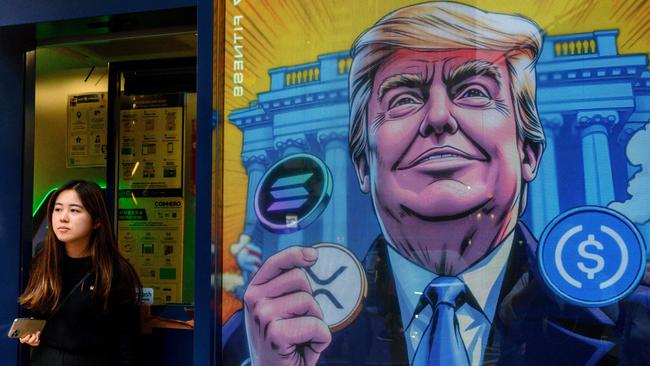
In the wake of Donald Trump’s re-election as POTUS, a handful of stocks and assets turned into rocket ships, propelled by animal spirits, the likes of which I haven’t witnessed in a while. An intoxicating mix of greed, optimism and unchecked exuberance over only a couple of months produced jaw-dropping gains for some.
Tesla surged nearly 100 per cent, riding a wave of post-election enthusiasm tied to Elon Musk’s support for Trump and speculation about the granting of advantage and favourable policies for Musk’s businesses in return.
Bitcoin climbed 60 per cent, fuelled by hopes of a crypto-friendly administration and Trump’s hints at a national cryptocurrency reserve.
Palantir blasted 200 per cent higher, buoyed by its ties to Peter Thiel, a Trump ally, and expectations of increased government contracts for its AI-driven data analytics.
These weren’t just isolated cases. Other examples from the same very brief period between November and the first quarter of this year include Coinbase, which jumped more than 60 per cent as crypto optimism spread, and Geo Group, a private prison operator, which doubled on expectations of stricter immigration enforcement.
The gains were immense, and their frequency and magnitude tells you something about the digitally connected world we now live in. No longer are retail investors waiting for tomorrow’s newspaper to tell them what’s happening in markets. The distribution of information, both accurate and fluff, is instantaneous.
Rather than trends lasting years, they’re now near-vertical spikes compacted into weeks or months. In the case of meme-coins, 7000 per cent gains and subsequent 95 per cent slumps occur over a few hours.
But the flip side of greed is fear. And the shadow of every steep climb is an equally steep drop. No asset can sustain parabolic growth indefinitely – it’s a law of financial physics.
Tesla has shed nearly 50 per cent from its post-election peak, rattled by disappointing delivery numbers and intensifying competition from China’s BYD. Bitcoin is down more than 20 per cent from its high above $US100,000, with a dip that briefly approached 30 per cent, as profit-taking and regulatory uncertainty crept in.

Palantir plummeted nearly 40 per cent, after investors questioned its sky-high valuation (it’s still over 70 times sales) amid a broader tech sell-off.
History is littered with similar tales. In 2021, GameStop soared more than 1500 per cent in weeks, only to crash 80 per cent shortly after. Even Nvidia, a darling of the AI boom, saw a 50 per cent-plus drop in 2022 after doubling in 2021. The pattern is clear: outsized gains in a compressed time frame come with the risk of outsized losses over an even shorter window.
This is how markets work. Wealth is transferred from the “know nothing” investor to the investors who know the most (and have great temperament). You generally can’t pocket and retain gigantic returns without handing at least some of it back.
So, how do you enjoy the ups without getting crushed by the downs? There are at least five possible tools for investors to consider when navigating these wild rides – assuming you bought a seat on the rollercoaster in the first place!
Before you buy, assume you don’t know everything, assume gravity is still functioning, and set multiple profit targets (for example 30 per cent, 50 per cent, 100 per cent, 200 per cent and 300 per cent) at which point you will reassess and carefully consider whether the company has genuinely increased its business value as much and as quickly as the price suggests. This is the important consideration. In the short term prices can and will disengage from the underlying business value. But in the longer term the two converge.

Next, acknowledge that timing the top is a fantasy. Acknowledging that fact might inform a decision to take profits incrementally when prices are soaring fast and high above underlying business value or business momentum. You might sell a quarter then a half and you keep the rest because you simply cannot forecast prices and the underlying business is a high-quality one growing its intrinsic value at double-digit rates – just not as fast as the share price.
What if the asset has no intrinsic value? During bitcoin’s 2021 run from $US30,000-$US69,000, scaling out at $US40,000 and $US50,000 would’ve banked profits while leaving room for more upside – without the sting of the drop to $US35,000.
Another handy tip is to watch for red flags. Vertical moves often end with warning signs: a massive volume spike (profit-taking), a “blow-off top”, or even a slight hush in hype on social media.
Keep your greed in check. Without a fundamental basis for the rally – increasing underlying business value, rather than a theme everyone is jumping on – FOMO (Fear of Missing Out) is fuelling the rally. Greed keeps you in too long. Stick to a plan, and plan to miss the top.
And finally, as boring as it sounds, diversify. Don’t bet the farm on one highflier. Spread your capital across sectors or assets with different drivers and low correlations. You can’t win at a game that you are no longer able to play.
The gamification of markets is well under way. More than ever, investors need to adapt.
Roger Montgomery is founder and CIO of Montgomery Investment Management






With all the current talk of a stockmarket correction, you might have entirely missed another example of irrational exuberance followed by despondency. What we have here is another period that offered an important lesson for investors – the need to adapt.